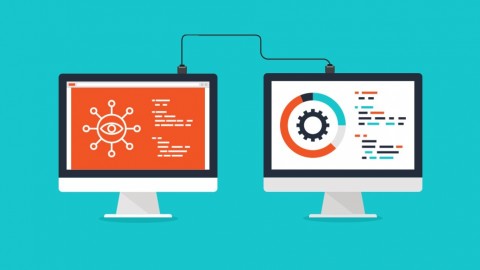
TCP/IP Socket Programming in C# .Net For Coders & Students
TCP/IP Socket Programming in C# .Net For Coders & Students, available at $74.99, has an average rating of 4.45, with 74 lectures, 3 quizzes, based on 1316 reviews, and has 11716 subscribers.
You will learn about TCP/IP Socket programming basics and advanced level with async/await in C# .Net Develop a sound understanding of how networking applications communicate in C# .Net Network Programming using .Net Framework networking Namespaces in C# C# Networking This course is ideal for individuals who are Take this course if you have some C# or Java programming experience or Network programming is a very interesting topic, if you're looking to study something off-beat in C# go for this course or Take this course only if you have never written code in any language (C#, C++, Java) It is particularly useful for Take this course if you have some C# or Java programming experience or Network programming is a very interesting topic, if you're looking to study something off-beat in C# go for this course or Take this course only if you have never written code in any language (C#, C++, Java).
Enroll now: TCP/IP Socket Programming in C# .Net For Coders & Students
Summary
Title: TCP/IP Socket Programming in C# .Net For Coders & Students
Price: $74.99
Average Rating: 4.45
Number of Lectures: 74
Number of Quizzes: 3
Number of Published Lectures: 74
Number of Published Quizzes: 3
Number of Curriculum Items: 77
Number of Published Curriculum Objects: 77
Original Price: $22.99
Quality Status: approved
Status: Live
What You Will Learn
- TCP/IP Socket programming basics and advanced level with async/await in C# .Net
- Develop a sound understanding of how networking applications communicate in C# .Net
- Network Programming using .Net Framework networking Namespaces in C#
- C# Networking
Who Should Attend
- Take this course if you have some C# or Java programming experience
- Network programming is a very interesting topic, if you're looking to study something off-beat in C# go for this course
- Take this course only if you have never written code in any language (C#, C++, Java)
Target Audiences
- Take this course if you have some C# or Java programming experience
- Network programming is a very interesting topic, if you're looking to study something off-beat in C# go for this course
- Take this course only if you have never written code in any language (C#, C++, Java)
Network and socket programming tutorial in C# .Net using TCP
Get proficient in computer network socket programming using TCP/IP streaming sockets and become a better professional programmer. This course will start you with TCP IP network programming with C# dotnet socket library and Dotnet fast.
Each video in this course covers an essential concept of client-server socket programming & network communication. The ready-to-use C# code examples are supplied in the Visual Studio solution form to download. After every few lectures, a demo will show you the practical implementation of the concepts described earlier.
By the end of this course, you will be able to create C# (Sharp) .Net software capable of sending and receiving data over TCP/IP sockets on a peer-to-peer basis with async and await keywords. You will learn not only socket programming but async/awaitkeywords as well. The course will make you a better programmer.
TCP/IP is a protocol suite that provides reliable, end-to-end communication over the Internet. It is not a layer in the OSI model but spans multiple layers, including the network layer (layer 3) and transport layer (layer 4). The TCP/IP protocol suite is designed to work on top of the underlying network infrastructure, allowing different network technologies to communicate with each other. While it doesn’t fit neatly into the OSI model, TCP/IP is widely used and is critical in modern networking.
Why take this course?
You should take this course if you’re a professional(or student) with some coding experience in the past but lack an understanding of how computer networks work on a software level(either in C#, Java, or C++).
You will learn valuable techniques in real-life scenarios commonly faced by programmers.
Many students of distributed application programming university courses have taken this course in the past and posted positive comments in reviews. They could quickly complete their assignments on their own after watching this course. This is the best socket programming course on Udemy.
Section 1 is free; it contains useful information anybody can benefit from, whether they’re familiar with C#.Net.
Minimum upfront theory
Many courses tend to pile up theory ahead of the actual code. This course is going to take a minimum theory-first approach.
You will learn the essentials of network programming and start writing C# code in under 15 minutes.
Use of Windows Forms and class library
TCP IP socket programming in C Sharp on Windows is the focus of this course. For example, this course will use a class library project in C# to show client/server applications in WinForms. This is an approach different from many other courses that use command-line projects. My teaching methodology makes the course much less boring, non-classroom-like, practically advantageous, and suitable for professionals.
Short, sweet, to the point
The entire course is designed with busy professionals in mind, and the videos were created to make your online learning experience fruitful and easy. It is project-based training.
Asynchronous programming with async/await keywords, a modern real-world solution
async/await keywords were introduced in C# 5.0. In traditional socket programming scenarios, (multi) threading creates a responsive server or client. I have bypassed that route and shown you how to use asynchronous sockets directly. I first explain to you what async/await keywords are. Then I show how to use these for non-blocking network I/O. This part of the puzzle is the key to high-traffic enterprise applications.
Reinforced learning
Each section contains a quiz at the end, which is very helpful to ensure that you review and retain essential bits of information imparted in a relevant course section.
Join an active community.
Become a part of the programmer community who has already taken this course. Your fellow students will answer your questions, and the course instructor as well. A wonderful place to start learning!
Learn something new
Sockets are considered an advanced topic, a danger zone in programming parlance. However, knowing it means you take your trade seriously.
Object Oriented Programming
This course teaches you how to create a distributed application using the principles of OOP. You will bridge the gap between the back-end C#.Net class library and the front-end WinForms application by implementing the Publisher/Subscriber model based on EventHandler classes. This course also shows you what event handlers are and how to create your event.
Bonus
You will also learn how to resolve a hostname to an IP Address using System.Net.DNS class. You’ll also implement various sanity checks using tryparse and try/catch.
You don’t need to learn C to work on this course.
There are a few key things to remember regarding TCP/IP socket programming in C#. First and foremost, it’s important to understand the basics of how sockets work and how they can be used to establish network connections between applications. In C#, you can use the Socket class to perform socket programming tasks and interact with network sockets. This class provides a range of methods and properties that allow you to create, connect, send, and receive data from sockets. With a solid understanding of the Socket class and its functionality, you can create robust and reliable network applications that communicate seamlessly with other applications over the internet.
TCP/IP, or Transmission Control Protocol/Internet Protocol, is the primary protocol used for communication on the Internet. Here are some pros and cons of using TCP/IP:
Pros of TCP/IP Sockets:
– TCP/IP is a widely adopted protocol, meaning that it is compatible with many different devices and networks.
– It is a reliable protocol that ensures data is transmitted accurately and in the correct order.
– TCP/IP can handle large amounts of data, making it suitable for use with high-bandwidth applications like video streaming.
Cons of TCP/IP Sockets:
– TCP/IP can be slow, particularly when compared to other protocols like UDP.
– The protocol is not particularly secure, meaning that data transmitted using TCP/IP is susceptible to interception and tampering.
– TCP/IP is relatively complex, meaning that it can be difficult to implement and maintain.
This course is related to Socket Java, Python socket, and UDP.
Course Curriculum
Chapter 1: Essential Networking Theory For Socket Programming
Lecture 1: Introduction to TCP/IP socket programming in C# .Net using Visual Studio
Lecture 2: Downloading Source Code
Lecture 3: The Host In Computer Network – Networking Essentials
Lecture 4: IP Address In Computer Network – Networking Essentials
Lecture 5: Port Numbers In Computer Network Socket Programming- Networking Essentials
Lecture 6: Client/Server Model as used in TCP/IP Stream Sockets – Networking Essentials
Lecture 7: Enable the Telnet client utility – Networking Essentials
Chapter 2: Socket Programming in C# For Beginners
Lecture 1: Server Side TCP/IP Socket Programming C# .Net Project Setup in Visual Studio
Lecture 2: Demo – Accept Incoming Connections on Socket in C# .Net Using Telnet Client
Lecture 3: Receive Data on a TCP/IP Socket in C# .Net
Lecture 4: Using Encoding.ASCII.GetString to Convert Bytes To String for socket transfer
Lecture 5: Socket Programming: Send Data on a TCP/IP Socket in C# .Net
Lecture 6: Socket Programming Example Demo – Send and Receive Data on TCP/IP Sockets in C#
Lecture 7: Demo – Communicate between C# desktop & Android app, configure Windows Firewall
Lecture 8: Introduction to Client Side TCP/IP Socket Programming in C# .Net
Lecture 9: Client Side Socket Programming VS Project Setup, using methods Connect, TryParse
Lecture 10: Socket.Send() & Socket.Receive() Calls On Client Side TCP/IP Socket in C#.Net
Lecture 11: Demo – Run TCP/IP Client & Server network programs, improve Server
Lecture 12: How to cleanup a console application for properly closing the TCP/IP Socket
Lecture 13: Section Summary
Chapter 3: TCP/IP Server Asynchronous Socket Programming With async & await Keywords in C#
Lecture 1: Section Intro: Asynchronous socket programming with async await in C# .Net
Lecture 2: Example: Disadvantage of synchronous I/O in C# .Net
Lecture 3: Accepting a TCPClient Connection Asynchronously with await keyword in C#
Lecture 4: Demo: Accept TCPClient Asynchronously
Lecture 5: Continuously Accept Client Connections, Exception Handling in C# async Method
Lecture 6: Use System.Net.Socket.NetworkStream & StreamReader to read data from client
Lecture 7: Demo: Read Data On Network Stream and Endless Accept async in C#.Net
Lecture 8: How to Handle Multiple Network Clients on Server in C# .Net
Lecture 9: Demo: Send Data to Multiple Network Clients from List at Once, SendAll Method
Lecture 10: How to Stop Listening for New Connections and Disconnect Client Sockets Properly
Lecture 11: Demo: TcpListener.Stop and TcpClient.Close Calls to Stop Server
Lecture 12: Section Summary: TCP/IP Server Side Asynchronous Socket Programming in C# .Net
Chapter 4: Async Client Side Socket Programming
Lecture 1: Client side async socket Visual Studio C# project setup
Lecture 2: Client Socket Programming using async keyword in C#.Net
Lecture 3: Creating a console application and adding C# socket library reference
Lecture 4: Reading data from TcpClient socket network stream with ReadAsync in C# .Net
Lecture 5: Demo: Async Client side TCP/IP socket programming in C# .Net
Lecture 6: Writing data on the a client socket with StreamWriter in C# .Net
Lecture 7: Demo: Write data on TcpClient network stream with StreamWriter in C#.Net
Lecture 8: Close Connection on TCPClient for socket programming in C# .Net
Lecture 9: Demo: Closing connection on TcpClient for socket programming in C# .Net
Lecture 10: Section Summary: Async client socket programming in C# .Net with async/await
Chapter 5: Using Publisher Subscriber Model To Add Events for socket library in C# .Net
Lecture 1: Introduction to pub/sub model and events/delegates in C#.Net
Lecture 2: Adding a ClientConnected event to the server socket library in C# .Net
Lecture 3: Adding a TextReceived event on the server to socket library in C# .Net
Lecture 4: Publishing event TextReceived on client to socket library in C# .Net
Lecture 5: Additional Events C# Source Code
Chapter 6: Socket Programming: Additional Helpful Topics in C# .Net
Lecture 1: Finding IP Address & Hostname of Your Windows PC from Command Prompt
Lecture 2: Role of DHCP and DNS in a Computer Network
Lecture 3: Resolving Hostname to IP Address Using System.Net.DNS for socket programming C#
Lecture 4: Demo: Resolving Hostname with System.Net.DNS Class in C# .Net
Lecture 5: How to use StreamReader.ReadLineAsync and StreamWriter.WriteLineAsync in C# .Net
Lecture 6: Bonus: UDP Socket Programming in C# .Net
Chapter 7: Deprecated Section: Creating a TCP/IP socket server
Lecture 1: Setting up the project in Visual Studio
Lecture 2: Preparing a TCPListener
Lecture 3: Listening for incoming connection requests
Lecture 4: Demo, incoming connection requests
Lecture 5: Getting hold of a TCPClient object
Lecture 6: Reading data from a TCPClient network stream
Lecture 7: Demo, reading data
Lecture 8: Writing data to a TCPClient network stream
Lecture 9: Demo, writing data
Chapter 8: Deprecated Section: Creating a TCP/IP socket client
Lecture 1: Setting up the project for socket client in Visual Studio
Lecture 2: Connect to a TCP/IP socket server in C# .Net
Lecture 3: Send data to a TCP/IP socket server
Lecture 4: Demo, connect to TCP/IP socket server and send data
Lecture 5: Receiving data from a server
Lecture 6: Demo, receiving data from server
Chapter 9: Deprecated Section: Common Network Programming Topics
Lecture 1: Understanding and Using Loop-back Address
Lecture 2: Finding IPv4 Address using Code
Lecture 3: Handling more than one clients connection requests on server
Lecture 4: Bonus: Maintaining a list of clients to handle multiple clients on your server
Lecture 5: Bonus: Demo – Handling multiple clients on TCP/IP server
Lecture 6: Listen for incoming connections on "Any" IP Address
Instructors
-
Naeem Akram
Test Engineer Sr.
Rating Distribution
- 1 stars: 19 votes
- 2 stars: 33 votes
- 3 stars: 157 votes
- 4 stars: 446 votes
- 5 stars: 661 votes
Frequently Asked Questions
How long do I have access to the course materials?
You can view and review the lecture materials indefinitely, like an on-demand channel.
Can I take my courses with me wherever I go?
Definitely! If you have an internet connection, courses on Udemy are available on any device at any time. If you don’t have an internet connection, some instructors also let their students download course lectures. That’s up to the instructor though, so make sure you get on their good side!
You may also like
- Best Video Editing Courses to Learn in March 2025
- Best Music Production Courses to Learn in March 2025
- Best Animation Courses to Learn in March 2025
- Best Digital Illustration Courses to Learn in March 2025
- Best Renewable Energy Courses to Learn in March 2025
- Best Sustainable Living Courses to Learn in March 2025
- Best Ethical AI Courses to Learn in March 2025
- Best Cybersecurity Fundamentals Courses to Learn in March 2025
- Best Smart Home Technology Courses to Learn in March 2025
- Best Holistic Health Courses to Learn in March 2025
- Best Nutrition And Diet Planning Courses to Learn in March 2025
- Best Yoga Instruction Courses to Learn in March 2025
- Best Stress Management Courses to Learn in March 2025
- Best Mindfulness Meditation Courses to Learn in March 2025
- Best Life Coaching Courses to Learn in March 2025
- Best Career Development Courses to Learn in March 2025
- Best Relationship Building Courses to Learn in March 2025
- Best Parenting Skills Courses to Learn in March 2025
- Best Home Improvement Courses to Learn in March 2025
- Best Gardening Courses to Learn in March 2025






















